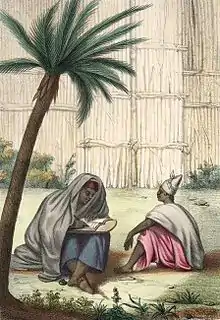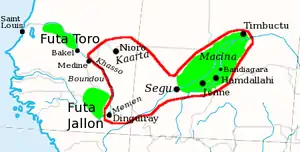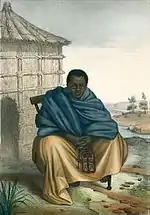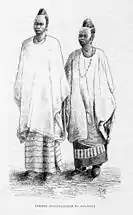Toucouleur people
The Toucouleur people, also called Tukulor or Haalpulaar, are a West African ethnic group native to Futa Tooro region of Senegal. There are smaller communities in Mali and Mauritania.[1] The Toucouleur were Islamized in the 11th century; their early and strong Islamic heritage, which is seen as a defining feature, is a "matter of great pride for them".[1][2] They have been influential in the spread of Islam to West Africa in the medieval era, later founded the vast Toucouleur Empire in the 19th century under El Hadj Umar Tall that led a religious war against their neighboring ethnic groups and the French colonial forces.[2][3]
 A Tukulor man and woman (1853 David Boilat painting) | |
| Total population | |
|---|---|
| 1 million (2010)[1] | |
| Regions with significant populations | |
| Senegal Mali Mauritania | |
| Languages | |
| Pulaar | |
| Religion | |
| Islam | |
| Related ethnic groups | |
| Serer people, Wolof people, Fulani people |
They speak the Pulaar language, and are distinct from but related to the Fula, Wolof and Serer people.[2] The Toucouleur are traditionally sedentary, settled primarily in the Senegal River valley, with farming, fishing and raising cattle as their main activities. The Toucouleur society has been patrilineal, polygynous and with high social stratification that included slavery and caste system.[1][2][4] There are an estimated 1 million Toucouleur people in West Africa.[1]
Distribution and languages

They are found primarily in the northern regions of Senegal where they constitute 15% of the population. This region is irrigated by the Senegal River valley, overlaps southern Mauritania. During the colonial era, and in the modern times, some of the Toucouleurs resettled in western Mali.[2] They are about a million Toucouleur people in Senegal River valley area, and about 100,000 in Mali.[1][5]
The Pulaar language, also called the Fula or Fulani language, is their first language. It is an Atlantic branch of the Niger-Congo language family of languages.[2] Locally, they are variously referred to as Pulaar: Torooɓe, Futanke, or Haalpulaar (French literature).[6]
The name Toucouleur is of unclear origin, with some sources stating it as a French derivation meaning "of every color", which itself may be a folk etymology. Other sources citing it as a deformation of tekruri a precolonial term meaning "people from Tekrur", signifying that they are descendants of the West African kingdom of Takrur that thrived between the 5th and 13th centuries.[7]
History
According to the oral traditions of the Toucouleurs and Serer people, the Toucouleurs are descendants of Serer and Fula ancestors.[8] This tradition is supported by many scholars including Foltz and Phillips.[8][9] A mutually acceptable bantering-style interaction, called the joking relationship by anthropologists, exists between the Serers and Toucouleurs.[10]
The Toucouleur people have long inhabited the Senegal River area, with roots of an organized Tekrur kingdom tracing back to the 5th century.[7] They were part of the 10th to the 18th century kingdom, but led by non-Toucouleur rulers from other ethnic groups. In the 18th century, a Toucouleur empire emerged which reached its peak influence in the 19th century under the Islamic leader El Hadj Umar Tall.[1] Umar was born in a Toucouleur clerical family in 1797.[11] During his visit to Mecca in 1827, he was designated as the "Caliph of Black Africa." He returned to West Africa in 1833, and subsequently learned political and state building strategies from his father-in-law in the Sokoto Caliphate.[3]

Umar Tall returned to Senegal in 1845, where he began preaching Islam among the Toucouleur people. Umar Tall obtained weapons from Europe,[12] then mobilized the Toucouleur to pursue an Islamic holy war in 1854 against the non-Muslim ethnic groups and those Muslims who had strayed.[3] The Toucouleur armies succeeded. The Toucouleur Empire grew and extended from Senegal to much of Mali over the next ten years. His son Mustafa reigned over this empire and Teucouleur people between 1864 and 1870, followed by Umar Tall's second son named Ahmadu Seku. The rule of Ahmadu Seku, state Gallieni and Joffre, was a "Toucouleur-Muslim despot" over the Mandinka people and Bambara people.[13] The empire collapsed in the 1880s as the Fulani, Tuaregs and the Moors attacked the Toucouleurs,[3] and a civil war between local Toucouleur leaders engulfed the region. The empire ended in 1891, after the French colonial forces invaded the region.[1]
People and society


The Toucouleurs speak the Futa Tooro dialect of Pulaar. They call themselves Haalpulaar’en, which means "those who speak Pulaar". They are Muslims. Culturally, the Toucouleur differ from other Fula people by the sedentary nature of their society.
Social stratification
Toucouleur society is patriarchal and divided into strict and rigid caste hierarchies.[1][14]
The highest status among the five Toucouleur castes is of the aristocratic leaders and Islamic scholars called Torobe. Below them are the Rimbe, or the administrators, traders and farmers. The Nyenbe are the artisan castes of the Toucouleur society. The fourth caste strata is called the Gallunkobe or the slaves or descendants of slaves "who have been freed". The bottom strata among the Toucouleurs are the Matyube or slaves.[1][15] The slaves were acquired by raiding pagan ethnic groups or purchased in slave markets,[16] or the status was inherited.[17]
The hierarchical social stratification has been an economically closed system, which historically has meant a marked inequality. Property and land has been exclusively owned by the upper caste members.[2][18] Occupations and caste memberships are inherited. The Toucouleur castes have been endogamous, segregated and intermarriage has been rare.[19][20] The clerics among Toucouleur like the Wolof people formed a separate group. The religious leaders were not necessarily endogamous nor an inherited post in Toucouleur people's long history, but it has been rare for lower caste people to become religious specialist, states Rüdiger Seesemann, as they were viewed as not sufficiently adhering to the "clerical standards of piety".[20]
Marriage

Marriage among the Toucouleurs requires a bride price payable to the bride's family. A girl from high social status family such as of noble lineage expects substantially higher payment than one of lower status such as artisan castes or with slave lineage.[2]
The marriage is validated by a mosque. The bride comes to live with her husband's joint family. Traditionally, before the marriage is consummated, the bride's aunt checks if the girl is a virgin, then bathes and massages her. The bride and groom then join in a wedding feast where the village members join in, marking the start of a new couple.
Childbirth and naming
One week after pémbougale (childbirth), the baby is named and a gorgol (sister of the father) cuts its hair. The father tells the marabout the name he has chosen, after which the marabout whispers the name in the infant's ear and prays. Following this, the marabout informs a gawlo "griot", of the name that has been chosen, and the griot announces the name to the village.
References
- Anthony Appiah; Henry Louis Gates (2010). Encyclopedia of Africa. Oxford University Press. pp. 500–501. ISBN 978-0-19-533770-9.
- Tukulor, Encyclopædia Britannica
- Wendy Doniger (1999). Merriam-Webster's Encyclopedia of World Religions. Merriam-Webster. p. 1116. ISBN 978-0-87779-044-0.
- Tal Tamari (1991). "The Development of Caste Systems in West Africa". The Journal of African History. Cambridge University Press. 32 (2): 221–250. doi:10.1017/s0021853700025718. JSTOR 182616., Quote: "Endogamous artisan and musician groups are characteristic of over fifteen West African peoples, including the Manding, Soninke, Wolof, Serer, Fulani, Tukulor, Songhay, Dogon, Senufo, Minianka, Moors, and Tuareg."
- Phillips, David J. (2001). Peoples on the Move: Introducing the Nomads of the World. William Carey Library. pp. 155, 161. ISBN 978-0-87808-352-7.CS1 maint: ref=harv (link)
- Roy M. Dilley (2014). Nearly Native, Barely Civilized: Henri Gaden’s Journey through Colonial French West Africa (1894-1939). BRILL Academic. pp. 1, 319–320. ISBN 978-90-04-26528-8.
- John A. Shoup (31 October 2011). Ethnic Groups of Africa and the Middle East: An Encyclopedia. ABC-CLIO. p. 97. ISBN 978-1-59884-362-0.
- Foltz, William J., "From French West Africa to the Mali Federation", Volume 12 of Yale studies in political science, p 136, Yale University Press (1965)
- Phillips, David J. (2001). Peoples on the Move: Introducing the Nomads of the World. William Carey Library. ISBN 978-0-87808-352-7.CS1 maint: ref=harv (link), p 161
- Foltz, William J., "From French West Africa to the Mali Federation", Volume 12. Yale studies in political science, p136. Yale University Press, 1965.
- Anthony Appiah; Henry Louis Gates (2010). Encyclopedia of Africa. Oxford University Press. p. 519. ISBN 978-0-19-533770-9.
- Anthony Appiah; Henry Louis Gates (2010). Encyclopedia of Africa. Oxford University Press. p. 126. ISBN 978-0-19-533770-9.
- Barnett Singer; John Langdon; John W. Langdon (2008). Cultured Force: Makers and Defenders of the French Colonial Empire. Univ of Wisconsin Press. p. 120. ISBN 978-0-299-19904-3.
- Marie-Hélène Le Divelec (1967), Les "nouvelles" classes sociales en milieu urbain : le cas du Sénégal et celui du Nigéria du Nord, Civilisations, Institut de Sociologie de l'Université de Bruxelles, Vol. 17, No. 3 (1967), pages 240-253; Quote: "In Senegal too the social structure is based on a rigid system of castes, each having a specific political, economic or ritual function. Caste antagonisms are much more important than tribal differences. "
- Eric Milet (2007). Mali: Magie d'un fleuve aux confins du désert (in French). Paris: Editions Olizane. p. 104. ISBN 978-2-88086-351-7.
- Amin, Samir (1972). "Underdevelopment and Dependence in Black Africa — Origins and Contemporary Forms". The Journal of Modern African Studies. Cambridge University Press. 10 (04): 503. doi:10.1017/s0022278x00022801.
- Martin A. Klein (1968). Islam and Imperialism in Senegal: Sine-Saloum, 1847-1914. Stanford University Press. pp. 7–11. ISBN 978-0-8047-0621-6.
- Tzeutschler, Gregory G. A. (1999). "Growing security: land rights and agricultural development in northern Senegal". Journal of African Law. Cambridge University Press. 43 (01): 36. doi:10.1017/s0021855300008718.
- John MOGEY and Heinz BACHMANN (1986), Kinship under two Strategies of Development, Journal of Comparative Family Studies, Vol. 17, No. 2 (SUMMER 1986), pages 233-244
- Rüdiger Seesemann (2011). The Divine Flood. Oxford University Press. pp. 154–155. ISBN 978-0-19-538432-1.
- This article includes some content that is a translation of the corresponding article from the French Wikipedia, accessed July 5, 2005.